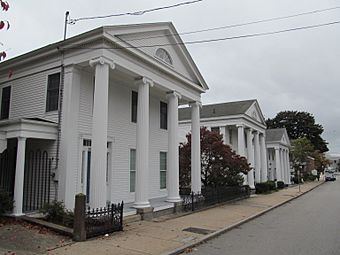Whale Oil Row facts for kids
Quick facts for kids |
|
|
Whale Oil Row
|
|

Whale Oil Row
|
|
| Location | 105-119 Huntington St., New London, Connecticut |
|---|---|
| Area | 3 acres (1.2 ha) |
| Built | 1835 |
| Built by | Charles Henry Boebe |
| Architectural style | Greek Revival |
| NRHP reference No. | 70000714 |
| Added to NRHP | December 29, 1970 |
Whale Oil Row is a collection of four beautiful houses located side by side in New London, Connecticut. You can find them at 105–119 Huntington Street. These homes were built between 1835 and 1845 by Charles Henry Boebe for a developer named Ezra Chappel. They show off the wealth and good taste of New London's rich families, who often made their money from the whaling industry. Because of their special history and design, these houses were added to the National Register of Historic Places in 1970.
What is Whale Oil Row?
Whale Oil Row is in downtown New London. It sits on the east side of Huntington Street, between Federal Street and Governor Winthrop Boulevard. All four buildings are two-and-a-half stories tall. They are made of wood and have sloped roofs. Most of their outside walls are covered with wooden boards called clapboards.
The Look of the Houses
What makes these houses special is their unique design. Each one has a two-story front porch that looks like a Greek temple. These porches have tall, fluted columns that support a decorated border. The triangular roof section above the porch is fully shaped like a pediment, with a half-circle window in the middle.
The first house, at 105 Huntington Street, is a bit wider than the others. Its front porch is in the middle, with extra space on each side. The other three houses have a simpler front. Their main entrance is on the left side, and the front walls are smooth.
History of the Houses
This group of high-quality houses, all designed like Greek temples, is quite rare in the United States. They were all built between 1835 and 1845. Three of the houses were owned by men who worked directly in New London's whaling business. The fourth house belonged to a merchant who sold dry goods.
For many years, these buildings were used as homes. But around the mid-1900s, they were all changed into offices for businesses. They still stand today as a reminder of New London's rich history and its connection to the whaling era.



